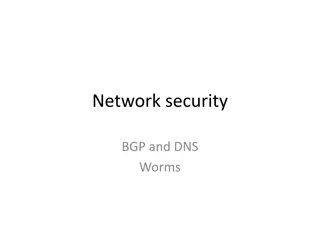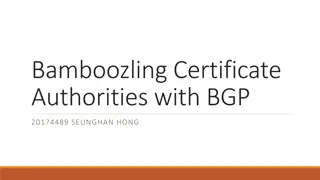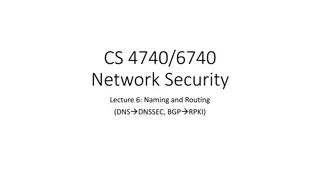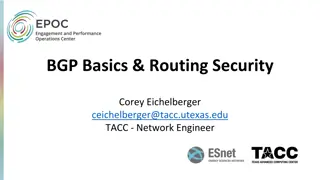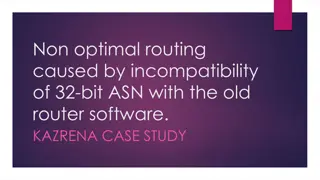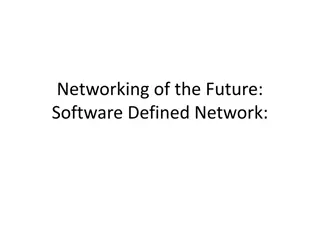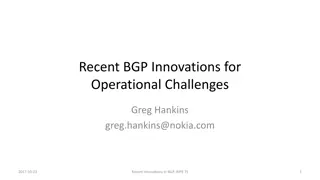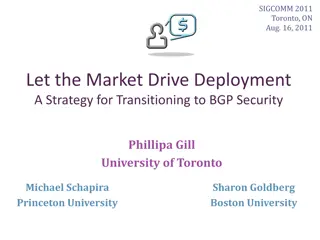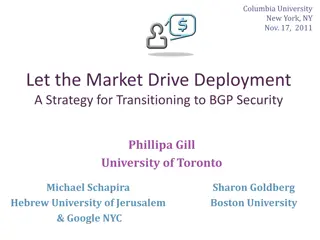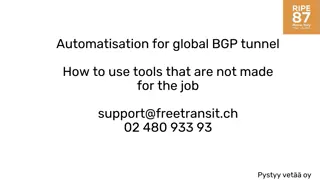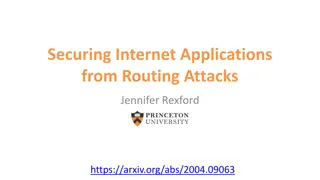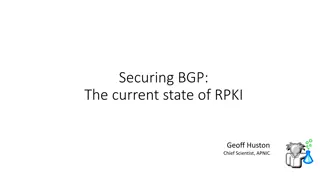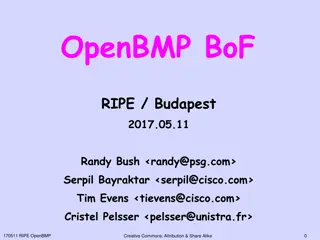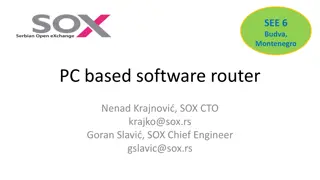
Understanding BGP Protocol and Configuration at AfNOG
"Explore the basics of Border Gateway Protocol (BGP) in this comprehensive guide covering protocol configuration, network design, multihoming, and service provider networks. Learn about stub AS, multihomed AS, iBGP, and more. Dive into case studies, exercises, and practical implementations for a deeper understanding of BGP in real-world scenarios." (286 characters)
Download Presentation

Please find below an Image/Link to download the presentation.
The content on the website is provided AS IS for your information and personal use only. It may not be sold, licensed, or shared on other websites without obtaining consent from the author. If you encounter any issues during the download, it is possible that the publisher has removed the file from their server.
You are allowed to download the files provided on this website for personal or commercial use, subject to the condition that they are used lawfully. All files are the property of their respective owners.
The content on the website is provided AS IS for your information and personal use only. It may not be sold, licensed, or shared on other websites without obtaining consent from the author.
E N D
Presentation Transcript
BGP Protocol & Configuration AfNOG
Border Gateway Protocol (BGP4) p Case Study 1, Exercise 1: Single upstream p Part 6: BGP Protocol Basics p Part 7: BGP Protocol - more detail p Case Study 2, Exercise 2: Local peer p Part 8: Routing Policy and Filtering p Exercise 3: Filtering on AS-path p Exercise 4: Filtering on prefix-list p Part 9: More detail than you want p Exercise 5: Interior BGP p Part 10: BGP and Network Design
BGP Part 10 BGP and Network Design
Stub AS p Enterprise network, or small ISP p Typically no need for BGP p Point default towards the ISP p ISP advertises the stub network to Internet p Policy confined within ISP policy
Stub AS AS 101 Provider B A AS 100 Customer
Multihomed AS p Enterprise network or small ISP p Only border routers speak BGP And others on direct path between them p iBGP only between border routers p Rest of network either has: exterior routes redistributed in a controlled fashion into IGP or use defaults (much preferred!)
Multi-homed AS AS 100 provider AS 300 provider D A C B AS 200 customer eBGP iBGP p More details on multihoming coming up...
Service Provider Network p iBGP used to carry exterior routes No redistribution into IGP p IGP used to track topology inside your network p Full iBGP mesh required Every router in ISP backbone should talk iBGP to every other router This has scaling problems, and solutions (e.g. route reflectors)
Common Service Provider Network AS 100 AS 200 A H B C AS 300 provider D F iBGP E G AS 400
Load-sharing single path p Router A: interface loopback 0 ip address 20.200.0.1 255.255.255.255 ! router bgp 100 neighbor 10.200.0.2 remote-as 200 neighbor 10.200.0.2 update-source loopback0 neighbor 10.200.0.2 ebgp-multihop 2 ! ip route 10.200.0.2 255.255.255.255 <DMZ-link1> ip route 10.200.0.2 255.255.255.255 <DMZ-link2> Loopback 0 10.200.0.2 AS100 AS200 A Loopback 0 20.200.0.1
Load-sharing multiple paths from the same AS p Router A: router bgp 100 neighbor 10.200.0.1 remote-as 200 neighbor 10.300.0.1 remote-as 200 maximum-paths 2 100 200 A Note: A still only advertises one best path to iBGP peers
Redundancy Multi-homing p Reliable connection to Internet p 3 common cases of multi-homing default from all providers customer + default from all providers full routes from all providers p Address Space comes from upstream providers, or allocated directly from registries
Default from all providers p Low memory/CPU solution p Provider sends BGP default provider is selected based on IGP metric p Inbound traffic decided by providers policy Can influence using outbound policy, example: AS-path prepend
Default from all providers Provider Provider AS 200 AS 300 D E Receive default from upstreams Receive default from upstreams A B AS 400 C
Customer prefixes plus default from all providers p Medium memory and CPU solution p Granular routing for customer routes, default for the rest Route directly to customers as those have specific policies p Inbound traffic decided by providers policies Can influence using outbound policy
Customer routes from all providers Customer AS 100 160.10.0.0/16 Provider Provider AS 300 AS 200 D E A B C chooses shortest AS path AS 400 C
Full routes from all providers p More memory/CPU p Fine grained routing control p Usually transit ASes take full routes p Usually pervasive BGP
Full routes from all providers AS 100 AS 500 AS 200 AS 300 D E A B C chooses shortest AS path AS 400 C
Best Practices IGP in Backbone p IGP connects your backbone together, not your clients routes Clients routes go into iBGP Hosting and service LANs go into iBGP Dial/Broadband/Wireless pools go into iBGP p IGP must converge quickly The fewer prefixes in the IGP the better p IGP should carry netmask information OSPF, IS-IS, EIGRP
Best Practices iBGP in Backbone p iBGP runs between all routers in backbone p Configuration essentials: Runs between loopbacks Next-hop-self Send-community Passwords All non-infrastructure prefixes go here
Best Practices... Connecting to a customer p Static routes You control directly No route flaps p Shared routing protocol or leaking Strongly discouraged You must filter your customers info Route flaps p BGP for multi-homed customers Private AS for those who multihome on to your backbone Public AS for the rest
Best Practices... Connecting to other ISPs p Advertise only what you serve p Take back as little as you can p Take the shortest exit p Aggregate your routes!! Consult RIPE-399 document for recommendations: http://www.ripe.net/docs/ripe-399.html p FILTER! FILTER! FILTER!
Summary p We have learned about: BGP Protocol Basics Routing Policy and Filtering BGP Best Path Computation Typical BGP topologies Routing Policy BGP Network Design Redundancy/Load sharing Some best practices

